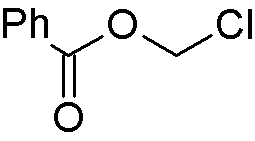Chloromethyl benzoate is widely utilized in research focused on:
- Synthesis of Fine Chemicals: This compound serves as an important intermediate in the production of various fine chemicals, including pharmaceuticals and agrochemicals, due to its reactivity and ability to introduce chloromethyl groups.
- Polymer Chemistry: It is used in the synthesis of specialty polymers, enhancing properties such as thermal stability and chemical resistance, making it valuable in industries like coatings and adhesives.
- Biochemical Research: Researchers utilize chloromethyl benzoate in the development of biochemical probes, aiding in the study of enzyme activity and cellular processes, which is crucial for drug discovery.
- Organic Synthesis: This compound is a key reagent in organic synthesis, facilitating the formation of complex molecules through various coupling reactions, beneficial for chemists in both academic and industrial settings.
- Flavor and Fragrance Industry: Chloromethyl benzoate is also explored for its potential applications in the flavor and fragrance sectors, where it can be used to create specific aromatic compounds, enhancing product appeal.
General Information
Properties
Safety and Regulations
Applications
Chloromethyl benzoate is widely utilized in research focused on:
- Synthesis of Fine Chemicals: This compound serves as an important intermediate in the production of various fine chemicals, including pharmaceuticals and agrochemicals, due to its reactivity and ability to introduce chloromethyl groups.
- Polymer Chemistry: It is used in the synthesis of specialty polymers, enhancing properties such as thermal stability and chemical resistance, making it valuable in industries like coatings and adhesives.
- Biochemical Research: Researchers utilize chloromethyl benzoate in the development of biochemical probes, aiding in the study of enzyme activity and cellular processes, which is crucial for drug discovery.
- Organic Synthesis: This compound is a key reagent in organic synthesis, facilitating the formation of complex molecules through various coupling reactions, beneficial for chemists in both academic and industrial settings.
- Flavor and Fragrance Industry: Chloromethyl benzoate is also explored for its potential applications in the flavor and fragrance sectors, where it can be used to create specific aromatic compounds, enhancing product appeal.
Documents
Safety Data Sheets (SDS)
The SDS provides comprehensive safety information on handling, storage, and disposal of the product.
Product Specification (PS)
The PS provides a comprehensive breakdown of the product’s properties, including chemical composition, physical state, purity, and storage requirements. It also details acceptable quality ranges and the product's intended applications.
Certificates of Analysis (COA)
Search for Certificates of Analysis (COA) by entering the products Lot Number. Lot and Batch Numbers can be found on a product’s label following the words ‘Lot’ or ‘Batch’.
*Catalog Number
*Lot Number
Certificates Of Origin (COO)
This COO confirms the country where the product was manufactured, and also details the materials and components used in it and whether it is derived from natural, synthetic, or other specific sources. This certificate may be required for customs, trade, and regulatory compliance.
*Catalog Number
*Lot Number
Safety Data Sheets (SDS)
The SDS provides comprehensive safety information on handling, storage, and disposal of the product.
DownloadProduct Specification (PS)
The PS provides a comprehensive breakdown of the product’s properties, including chemical composition, physical state, purity, and storage requirements. It also details acceptable quality ranges and the product's intended applications.
DownloadCertificates of Analysis (COA)
Search for Certificates of Analysis (COA) by entering the products Lot Number. Lot and Batch Numbers can be found on a product’s label following the words ‘Lot’ or ‘Batch’.
*Catalog Number
*Lot Number
Certificates Of Origin (COO)
This COO confirms the country where the product was manufactured, and also details the materials and components used in it and whether it is derived from natural, synthetic, or other specific sources. This certificate may be required for customs, trade, and regulatory compliance.


